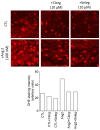Monoamine Oxidase (MAO) Is Expressed at the Level of Mitral Valve with Severe Regurgitation in Hypertrophic Obstructive Cardiomyopathy: A Case Report
- PMID: 36557046
- PMCID: PMC9782643
- DOI: 10.3390/medicina58121844
Monoamine Oxidase (MAO) Is Expressed at the Level of Mitral Valve with Severe Regurgitation in Hypertrophic Obstructive Cardiomyopathy: A Case Report
Abstract
Hypertrophic obstructive cardiomyopathy (HOCM) is one of the most common hereditary heart diseases. The severely hypertrophied interventricular septum combined with the systolic anterior movement (SAM) of the mitral valve (MV) frequently cause a significant pressure gradient in the left ventricular outflow tract associated with varying degrees of mitral regurgitation (MR). We present the case of a 64-year-old female patient who was diagnosed with HOCM two years ago and was admitted to the Institute of Cardiovascular Disease with exertion dyspnea and fatigue. Transthoracic echocardiography revealed concentric, asymmetrical left ventricular hypertrophy, an elongated anterior mitral leaflet (AML) and a significant SAM causing severe regurgitation, with indication for valvular replacement Monoamine oxidase (MAO), a mitochondrial enzyme, with 2 isoforms, MAO-A and B, has emerged as an important source of reactive oxygen species (ROS) in the cardiovascular system, but literature data on its expression in valvular tissue is scarce. Therefore, we assessed MAO-A and B gene (qPCR) and protein (immune fluorescence) expression as well as ROS production (spectrophotometry and confocal microscopy) and in the explanted MV harvested during replacement surgery. MAO expression and ROS production (assessed by both methods) were further augmented following ex vivo incubation with angiotensin II, an effect that was reversed in the presence of either MAO-A (clorgyline) or B (selegiline) inhibitor, respectively. In conclusion, MAO isoforms are expressed at the level of severely impaired mitral valve in the setting of HOCM and can be induced in conditions that mimic the activation of renin-angiotensin-aldosterone system. The observation that the enzyme can be modulated by MAO inhibitors warrants further investigation in a patient cohort.
Keywords: MAO inhibitors; hypertrophic obstructive cardiomyopathy; mitral valve regurgitation; monoamine oxidase; oxidative stress.
Conflict of interest statement
The authors declare no conflict of interest.
Figures




Similar articles
-
Monoamine Oxidase Contributes to Valvular Oxidative Stress: A Prospective Observational Pilot Study in Patients with Severe Mitral Regurgitation.Int J Mol Sci. 2024 Sep 25;25(19):10307. doi: 10.3390/ijms251910307. Int J Mol Sci. 2024. PMID: 39408637 Free PMC article.
-
Hypertrophic obstructive cardiomyopathy with abnormalities of the mitral valve complex.J Heart Valve Dis. 1997 Jan;6(1):60-2. J Heart Valve Dis. 1997. PMID: 9044078
-
[Isolated Mitral Valve Replacement was Effective in Patient with Hypertrophic Obstructive Cardiomyopathy and Concomitant Mitral Regurgitation;Report of a Case].Kyobu Geka. 2019 Feb;72(2):149-152. Kyobu Geka. 2019. PMID: 30772883 Japanese.
-
Mitral regurgitation in hypertrophic obstructive cardiomyopathy: The role of the edge-to-edge technique.J Card Surg. 2022 Oct;37(10):3336-3341. doi: 10.1111/jocs.15826. Epub 2021 Jul 19. J Card Surg. 2022. PMID: 36054469 Review.
-
[Surgical management of hypertrophic obstructive cardiomyopathy: the role of mitral valve].G Ital Cardiol (Rome). 2019 Feb;20(2):109-116. doi: 10.1714/3093.30858. G Ital Cardiol (Rome). 2019. PMID: 30747926 Review. Italian.
Cited by
-
Monoamine Oxidase Contributes to Valvular Oxidative Stress: A Prospective Observational Pilot Study in Patients with Severe Mitral Regurgitation.Int J Mol Sci. 2024 Sep 25;25(19):10307. doi: 10.3390/ijms251910307. Int J Mol Sci. 2024. PMID: 39408637 Free PMC article.
References
-
- Elliott P.M., Anastasakis A., Borger M.A., Borggrefe M., Cecchi F., Charron P., Hagege A.A., Lafont A., Limongelli G., Mahrholdt H., et al. 2014 Esc Guidelines on Diagnosis and Management of Hypertrophic Cardiomyopathy: The Task Force for the Diagnosis and Management of Hypertrophic Cardiomyopathy of the European Society of Cardiology (Esc) Eur. Heart J. 2014;35:2733–2779. - PubMed
-
- Shah A.K., Bhullar S.K., Elimban V., Dhalla N.S. Role of angiotensin II in the development of subcellular remodeling in heart failure. Explor. Med. 2021;2:352–371.
-
- Miller J.D., Chu Y., Brooks R.M., Richenbacher W.E., Peña-Silva R., Heistad D.D. Dysregulation of Antioxidant Mechanisms Contributes to Increased Oxidative Stress in Calcific Aortic Valvular Stenosis in Humans. J. Am. Coll. Cardiol. 2008;52:843–850. doi: 10.1016/j.jacc.2008.05.043. - DOI - PMC - PubMed
Publication types
MeSH terms
Substances
LinkOut - more resources
Full Text Sources

